Harnessing Multi-Photon Absorption to Produce Three-Dimensional Magnetic Structures at the Nanoscale
Abstract
1. Introduction
2. Experimental Setup and Physics of Two-Photon Lithography
3. Fabrication of Magnetic Nanostructures with Two-Photon Lithography
3.1. TPL and Electrodeposition
3.2. TPL and Line of Sight Deposition
4. Methods to Reduce Feature Size
5. Outlook
Author Contributions
Funding
Acknowledgments
Conflicts of Interest
References
- Andrus, J.; Bond, W.L. Photoengraving in transistor fabrication. Transistor Technol. 1958, 3, 151–162. [Google Scholar]
- Lojek, B. History of Semiconductor Engineering; Springer Science & Business Media: Berlin, Germany, 2007; p. 193. [Google Scholar]
- Bobeck, A.; Danylchuk, I. Characterization and test-results for a 272k bubble memory package. IEEE Trans. Magn. 1977, 13, 1370–1372. [Google Scholar] [CrossRef]
- Thompson, D.; Romankiw, L.; Mayadas, A. Thin-film magnetoresistors in memory, storage, and related applications. IEEE Trans. Magn. 1975, 11, 1039–1050. [Google Scholar] [CrossRef]
- Baibich, M.N.; Broto, J.M.; Fert, A.; Vandau, F.N.; Petroff, F.; Eitenne, P.; Creuzet, G.; Friederich, A.; Chazelas, J. Giant Magnetoresistance of (001)Fe/(001) Cr Magnetic Superlattices. Phys. Rev. Lett. 1988, 61, 2472–2475. [Google Scholar] [CrossRef] [PubMed]
- Julliere, M. Tunneling between Ferromagnetic-Films. Phys. Lett. A 1975, 54, 225–226. [Google Scholar] [CrossRef]
- Tsang, C.; Decker, S.K. The Origin of Barkhausen Noise in Small Permalloy Magnetoresistive Sensors. J. Appl. Phys. 1981, 52, 2465–2467. [Google Scholar] [CrossRef]
- Shinjo, T.; Okuno, T.; Hassdorf, R.; Shigeto, K.; Ono, T. Magnetic vortex core observation in circular dots of permalloy. Science 2000, 289, 930–932. [Google Scholar] [CrossRef] [PubMed]
- Cowburn, R.P.; Allwood, D.A.; Xiong, G.; Cooke, M.D. Domain wall injection and propagation in planar Permalloy nanowires. J. Appl. Phys. 2002, 91, 6949–6951. [Google Scholar] [CrossRef]
- Cowburn, R.P.; Koltsov, D.K.; Adeyeye, A.O.; Welland, M.E.; Tricker, D.M. Single-domain circular nanomagnets. Phys. Rev. Lett. 1999, 83, 1042–1045. [Google Scholar] [CrossRef]
- Slonczewski, J.C. Current-driven excitation of magnetic multilayers. J. Magn. Magn. Mater. 1996, 159, L1–L7. [Google Scholar] [CrossRef]
- Berger, L. Emission of spin waves by a magnetic multilayer traversed by a current. Phys. Rev. B 1996, 54, 9353–9358. [Google Scholar] [CrossRef] [PubMed]
- Lewis, E.R.; Petit, D.; O’Brien, L.; Fernandez-Pacheco, A.; Sampaio, J.; Jausovec, A.V.; Zeng, H.T.; Read, D.E.; Cowburn, R.P. Fast domain wall motion in magnetic comb structures. Nat. Mater. 2010, 9, 980–983. [Google Scholar] [CrossRef] [PubMed]
- Parkin, S.S.P.; Hayashi, M.; Thomas, L. Magnetic domain-wall racetrack memory. Science 2008, 320, 190–194. [Google Scholar] [CrossRef] [PubMed]
- Meier, J.; Doudin, B.; Ansermet, J. Magnetic properties of nanosized wires. J. Appl. Phys. 1996, 79, 6010–6012. [Google Scholar] [CrossRef]
- Ferre, R.; Ounadjela, K.; George, J.; Piraux, L.; Dubois, S. Magnetization processes in nickel and cobalt electrodeposited nanowires. Phys. Rev. B 1997, 56, 14066–14075. [Google Scholar] [CrossRef]
- Metzger, R.; Konovalov, V.; Sun, M.; Xu, T.; Zangari, G.; Xu, B.; Benakli, M.; Doyle, W. Magnetic nanowires in hexagonally ordered pores of alumina. IEEE Trans. Magn. 2000, 36, 30–35. [Google Scholar] [CrossRef]
- García, J.; Vega, V.; Iglesias, L.; Prida, V.M.; Hernando, B.; Barriga-Castro, E.D.; Mendoza-Reséndez, R.; Luna, C.; Görlitz, D.; Nielsch, K. Template-assisted Co–Ni alloys and multisegmented nanowires with tuned magnetic anisotropy. Phys. Status Solidi A 2014, 211, 1041–1047. [Google Scholar] [CrossRef]
- Shevchenko, E.V.; Talapin, D.V.; Rogach, A.L.; Kornowski, A.; Haase, M.; Weller, H. Colloidal synthesis and self-assembly of CoPt3 nanocrystals. J. Am. Chem. Soc. 2002, 124, 11480–11485. [Google Scholar] [CrossRef]
- Petit, C.; Legrand, J.; Russier, V.; Pileni, M.P. Three dimensional arrays of cobalt nanocrystals: Fabrication and magnetic properties. J. Appl. Phys. 2002, 91, 1502–1508. [Google Scholar] [CrossRef]
- Maruo, S.; Nakamura, O.; Kawata, S. Three-dimensional microfabrication with two-photon-absorbed photopolymerization. Opt. Lett. 1997, 22, 132–134. [Google Scholar] [CrossRef]
- Sun, H.B.; Matsuo, S.; Misawa, H. Three-dimensional photonic crystal structures achieved with two-photon-absorption photopolymerization of resin. Appl. Phys. Lett. 1999, 74, 786–788. [Google Scholar] [CrossRef]
- Borisov, R.A.; Dorojkina, G.N.; Koroteev, N.I.; Kozenkov, V.M.; Magnitskii, S.A.; Malakhov, D.V.; Tarasishin, A.V.; Zheltikov, A.M. Fabrication of three-dimensional periodic microstructures by means of two-photon polymerization. Appl. Phys. B Lasers Opt. 1998, 67, 765–767. [Google Scholar] [CrossRef]
- Chen, L.; Lopez-Garcia, M.; Taverne, M.; Zheng, X.; Ho, Y.; Rarity, J. Direct wide-angle measurement of a photonic band structure in a three-dimensional photonic crystal using infrared Fourier imaging spectroscopy. Opt. Lett. 2017, 42, 1584–1587. [Google Scholar] [CrossRef]
- Hu, Y.; Miles, B.; Ho, Y.; Taverne, M.; Chen, L.; Gersen, H.; Rarity, J.; Faul, C. Toward Direct Laser Writing of Actively Tuneable 3D Photonic Crystals. Adv. Opt. Mater. 2017, 5, 1600458. [Google Scholar] [CrossRef]
- Chen, L.; Morgan, K.; Alzaidy, G.; Huang, C.; Ho, Y.; Taverne, M.; Zheng, X.; Ren, Z.; Feng, Z.; Zeimpekis, I.; et al. Observation of Complete Photonic Bandgap in Low Refractive Index Contrast Inverse Rod-Connected Diamond Structured Chalcogenides. ACS Photonics 2019, 6, 1248–1254. [Google Scholar] [CrossRef]
- Kumi, G.; Yanez, C.O.; Belfield, K.D.; Fourkas, J.T. High-speed multiphoton absorption polymerization: Fabrication of microfluidic channels with arbitrary cross-sections and high aspect ratios. Lab Chip 2010, 10, 1057–1060. [Google Scholar] [CrossRef]
- Song, J.X.; Michas, C.; Chen, C.S.; White, A.E.; Grinstaff, M.W. From Simple to Architecturally Complex Hydrogel Scaffolds for Cell and Tissue Engineering Applications: Opportunities Presented by Two-Photon Polymerization. Adv. Healthc. Mater. 2019, 9, 1901217. [Google Scholar] [CrossRef]
- Thompson, J.R.; Worthington, K.S.; Green, B.J.; Mullin, N.K.; Jiao, C.H.; Kaalberg, E.E.; Wiley, L.A.; Han, I.C.; Russell, S.R.; Sohn, E.H.; et al. Two-photon polymerized poly(caprolactone) retinal cell delivery scaffolds and their systemic and retinal biocompatibility. Acta Biomater. 2019, 94, 204–218. [Google Scholar] [CrossRef]
- Worthington, K.; Thompson, J.; Shrestha, A.; Jiao, C.H.; Kaalberg, E.; Green, B.; Wiley, L.; Guymon, C.A.; Russell, S.; Sohn, E.; et al. Two-Photon Polymerized Poly(Caprolactone) as a High-Resolution, 3D-Printed Cell Delivery Scaffold. Mol. Ther. 2018, 26, 427. [Google Scholar]
- Worthington, K.S.; Thompson, J.R.; Green, B.J.; Bunn, S.J.; Kaalberg, E.E.; Johnston, R.M.; Wiley, L.A.; Mullins, R.F.; Stone, E.M.; Guymon, C.A.; et al. Two-Photon Polymerization of High-Resolution 3D, Biodegradable Photoreceptor Cell Scaffolds. Investig. Ophthalmol. Vis. Sci. 2017, 58, 12300. [Google Scholar]
- Fernandez-Pacheco, A.; Streubel, R.; Fruchart, O.; Hertel, R.; Fischer, P.; Cowburn, R. Three-dimensional nanomagnetism. Nat. Commun. 2017, 8, 1–14. [Google Scholar] [CrossRef] [PubMed]
- Da Col, S.; Jamet, S.; Rougemaille, N.; Locatelli, A.; Mentes, T.; Burgos, B.; Afid, R.; Darques, M.; Cagnon, L.; Toussaint, J.; et al. Observation of Bloch-point domain walls in cylindrical magnetic nanowires. Phys. Rev. B 2014, 89, 180405. [Google Scholar] [CrossRef]
- Schobitz, M.; De Riz, A.; Martin, S.; Bochmann, S.; Thirion, C.; Vogel, J.; Foerster, M.; Aballe, L.; Mentes, T.O.; Locatelli, A.; et al. Fast Domain Wall Motion Governed by Topology and OErsted Fields in Cylindrical Magnetic Nanowires. Phys. Rev. Lett. 2019, 123, 217201. [Google Scholar] [CrossRef] [PubMed]
- Yan, M.; Andreas, C.; Kákay, A.; García-Sánchez, F.; Hertel, R. Fast domain wall dynamics in magnetic nanotubes: Suppression of Walker breakdown and Cherenkov-like spin wave emission. Appl. Phys. Lett. 2011, 99, 122505. [Google Scholar] [CrossRef]
- Xia, J.; Zhang, X.; Yan, M.; Zhao, W.; Zhou, Y. Spin-Cherenkov effect in a magnetic nanostrip with interfacial Dzyaloshinskii-Moriya interaction. Sci. Rep. 2016, 6, 25189. [Google Scholar] [CrossRef]
- Sheka, D.D.; Kravchuk, V.P.; Gaididei, Y. Curvature effects in statics and dynamics of low dimensional magnets. J. Phys. A Math. Theor. 2015, 48, 125202. [Google Scholar] [CrossRef]
- Streubel, R.; Fischer, P.; Kronast, F.; Kravchuk, V.; Sheka, D.; Gaididei, Y.; Schmidt, O.; Makarov, D. Magnetism in curved geometries. J. Phys. D Appl. Phys. 2016, 49, 363001. [Google Scholar] [CrossRef]
- Yershov, K.; Kravchuk, V.; Sheka, D.; Gaididei, Y. Curvature-induced domain wall pinning. Phys. Rev. B 2015, 92, 104412. [Google Scholar] [CrossRef]
- Gaididei, Y.; Kravchuk, V.P.; Sheka, D.D. Curvature Effects in Thin Magnetic Shells. Phys. Rev. Lett. 2014, 112, 257203. [Google Scholar] [CrossRef]
- Pimpin, A.; Srituravanich, W. Review on Micro- and Nanolithography Techniques and their Applications. Eng. J. 2012, 16, 37. [Google Scholar] [CrossRef]
- Silva, F.A. Smart Sensors and MEMS: Intelligent Devices and Microsystems for Industrial Applications; IEEE: Piscataway, NJ, USA, 2014. [Google Scholar]
- Shaw, J.; Gelorme, J.; LaBianca, N.; Conley, W.; Holmes, S. Negative photoresists for optical lithography. IBM J. Res. Dev. 1997, 41, 81–94. [Google Scholar] [CrossRef]
- Fischer, J. Three-dimensional Optical Lithography beyond the Diffraction Limit. Ph.D. Thesis, Karlsruhe Institute of Technology, Karlsruhe, Germany, 2012. [Google Scholar] [CrossRef]
- Swinehart, D.F. The Beer-Lambert Law. J. Chem. Educ. 1962, 39, 333. [Google Scholar] [CrossRef]
- Zhou, X.; Hou, Y.; Lin, J. A review on the processing accuracy of two-photon polymerization. AIP Adv. 2015, 5, 030701. [Google Scholar] [CrossRef]
- Cao, H.Z.; Zheng, M.L.; Dong, X.Z.; Jin, F.; Zhao, Z.S.; Duan, X.M. Two-photon nanolithography of positive photoresist thin film with ultrafast laser direct writing. Appl. Phys. Lett. 2013, 102, 201108. [Google Scholar] [CrossRef]
- Nikogosyan, D.; Angelov, D. Formation of free-radicals in water under high-power laser uv irradiation. Chem. Phys. Lett. 1981, 77, 208–210. [Google Scholar] [CrossRef]
- Reintjes, J.; Eckardt, R. Two-photon absorption an ADP and KD*P at 266.1 nm. IEEE J. Quantum Electron. 1977, 13, 791–795. [Google Scholar] [CrossRef]
- Nathan, V.; Guenther, A.; Mitra, S. Review of multiphoton absorption in crystalline solids. J. Opt. Soc. Am. B Opt. Phys. 1985, 2, 294–316. [Google Scholar] [CrossRef]
- Fox, M. Optical Properties of Solids; AAPT: College Park, MD, USA, 2002. [Google Scholar]
- Mills, I. Quantities, Units and Symbols in Physical Chemistry/Prepared for Publication by Ian Mills...[et al.]; Blackwell Science: Oxford, MI, USA; Boston, MA, USA; CRC Press: Boca Raton, FL, USA, 1993. [Google Scholar]
- Da Col, S.; Jamet, S.; Stano, M.; Trapp, B.; Le Denmat, S.; Cagnon, L.; Toussaint, J.; Fruchart, O. Nucleation, imaging, and motion of magnetic domain walls in cylindrical nanowires. Appl. Phys. Lett. 2016, 109, 4961058. [Google Scholar] [CrossRef]
- Staňo, M.; Fruchart, O. Chapter 3—Magnetic Nanowires and Nanotubes. In Handbook of Magnetic Materials; Brück, E., Ed.; Elsevier: Amsterdam, The Netherlands, 2018; pp. 155–267. [Google Scholar]
- Bran, C.; Berganza, E.; Fernandez-Rolden, J.A.; Palmero, E.M.; Meier, J.; Calle, E.; Jaafar, M.; Foerster, M.; Aballe, L.; Rodriguez, A.F.; et al. Magnetization ratchet in cylindrical nanowires. ACS Nano 2018, 12, 5932–5939. [Google Scholar] [CrossRef]
- Zhang, H.; Zhang, X.; Zhang, J.; Li, Z.; Sun, H. Template-Based Electrodeposition Growth Mechanism of Metal Nanotubes. J. Electrochem. Soc. 2013, 160, D41–D45. [Google Scholar] [CrossRef]
- Gliga, S.; Seniutinas, G.; Weber, A.; David, C. Architectural structures open new dimensions in magnetism Magnetic buckyballs. Mater. Today 2019, 26, 100–101. [Google Scholar] [CrossRef]
- Bran, C.; Ivanov, Y.P.; Kosel, J.; Chubykalo-Fesenko, O.; Vazquez, M. Co/Au multisegmented nanowires: A 3D array of magnetostatically coupled nanopillars. Nanotechnology 2017, 28, 095709. [Google Scholar] [CrossRef] [PubMed]
- Ferain, E.; Legras, R. Track-etch templates designed for micro- and nanofabrication. Nucl. Instrum. Methods Phys. Res. Sect. B Beam Interact. Mater. Atoms 2003, 208, 115–122. [Google Scholar] [CrossRef]
- Apel, P.Y.; Dmitriev, S.N. Micro-and nanoporous materials produced using accelerated heavy ion beams. Adv. Nat. Sci. Nanosci. Nanotechnol. 2011, 2, 013002. [Google Scholar] [CrossRef]
- Tsutsumi, N.; Fukuda, A.; Nakamura, R.; Kinashi, K.; Sakai, W. Fabrication of three-dimensional microstructures in positive photoresist through two-photon direct laser writing. Appl. Phys. A 2017, 123, 553. [Google Scholar] [CrossRef]
- MicroChemicals. Development of Photoresists. Available online: http://www.microchemicals.com (accessed on 26 October 2019).
- Zeeshan, M.A.; Grisch, R.; Pellicer, E.; Sivaraman, K.M.; Peyer, K.E.; Sort, J.; Özkale, B.; Sakar, M.S.; Nelson, B.J.; Pané, S. Hybrid Helical Magnetic Microrobots Obtained by 3D Template-Assisted Electrodeposition. Small 2014, 10, 1284–1288. [Google Scholar] [CrossRef]
- Alcantara, C.; Kim, S.; Lee, S.; Jang, B.; Thakolkaran, P.; Kim, J.; Choi, H.; Nelson, B.; Pane, S. 3D Fabrication of Fully Iron Magnetic Microrobots. Small 2019, 15, 1805006. [Google Scholar] [CrossRef]
- Williams, G.I.; Hunt, M.; Boehm, B.; Ho, D.; Taverne, M.; Allenspach, R.; Rarity, J.; Ladak, S. Two photon lithography for 3D Magnetic Nanostructure Fabrication. Nano Res. 2018, 11, 845–854. [Google Scholar] [CrossRef]
- Sahoo, S.; Mondal, S.; Williams, G.; May, A.; Ladak, S.; Barman, A. Ultrafast magnetization dynamics in a nanoscale three-dimensional cobalt tetrapod structure. Nanoscale 2018, 10, 9981–9986. [Google Scholar] [CrossRef]
- Schurch, P.; Petho, L.; Schwiedrzik, J.; Michler, J.; Philippe, L. Additive Manufacturing through Galvanoforming of 3D Nickel Microarchitectures: Simulation-Assisted Synthesis. Adv. Mater. Technol. 2018, 3, 1800274. [Google Scholar] [CrossRef]
- Richardson, D.; Kingston, S.; Rhen, F.M.F. Synthesis and Characterization of Ni-Fe-B Nanotubes. IEEE Trans. Magn. 2015, 51, 1–4. [Google Scholar] [CrossRef]
- Tierno, P.; Goedel, W.A. Using Electroless Deposition for the Preparation of Micro Sized Polymer/Metal Core/Shell Particles and Hallow Metal Spheres. J. Phys. Chem. B 2006, 110, 3043–3050. [Google Scholar] [CrossRef] [PubMed]
- Yan, Y.; Rashad, M.; Teo, E.; Tanoto, H.; Teng, J.; Bettiol, A. Selective electroless silver plating of three dimensional SU-8 microstructures on silicon for metamaterials applications. Opt. Mater. Express 2011, 1, 1548–1554. [Google Scholar] [CrossRef]
- Wang, W.-K.; Sun, Z.-B.; Zheng, M.-L.; Dong, X.-Z.; Zhao, Z.-S.; Duan, X.-M. Magnetic Nickel–Phosphorus/Polymer Composite and Remotely Driven Three-Dimensional Micromachine Fabricated by Nanoplating and Two-Photon Polymerization. J. Phys. Chem. C 2011, 115, 11275–11281. [Google Scholar] [CrossRef]
- Kavaldzhiev, M.; Perez, J.; Ivanov, Y.; Bertoncini, A.; Liberale, C.; Kosel, J. Biocompatible 3D printed magnetic micro needles. Biomed. Phys. Eng. Express 2017, 3, 025005. [Google Scholar] [CrossRef]
- Kim, S.; Qiu, F.; Kim, S.; Ghanbari, A.; Moon, C.; Zhang, L.; Nelson, B.J.; Choi, H. Fabrication and Characterization of Magnetic Microrobots for Three-Dimensional Cell Culture and Targeted Transportation. Adv. Mater. 2013, 25, 5863–5868. [Google Scholar] [CrossRef] [PubMed]
- Tottori, S.; Zhang, L.; Qiu, F.; Krawczyk, K.; Franco-Obregon, A.; Nelson, B. Magnetic Helical Micromachines: Fabrication, Controlled Swimming, and Cargo Transport. Adv. Mater. 2012, 24, 811–816. [Google Scholar] [CrossRef]
- May, A.; Hunt, M.; van den Berg, A.; Hejazi, A.; Ladak, S. Realisation of a 3D frustrated magnetic nanowire lattice. Commun. Phys. 2019, 2, 13. [Google Scholar] [CrossRef]
- Donnelly, C.; Scagnoli, M.G.-S.V.; Holler, M.; Huthwelker, T.; Menzel, A.; Vartiainen, I.; Müller, E.; Kirk, E.; Gliga, S.; Raabe, J.; et al. Element-Specific X-Ray Phase Tomography of 3D Structures at the Nanoscale. Phys. Rev. Lett. 2015, 114, 115501. [Google Scholar] [CrossRef]
- Fischer, P.; Ohldag, H. X-rays and magnetism. Rep. Prog. Phys. 2015, 78, 094501. [Google Scholar] [CrossRef]
- Gilbertson, A.M.; Benstock, D.; Fearn, M.; Kormanyos, A.; Ladak, S.; Emeny, M.T.; Lambert, C.J.; Ashley, T.; Solin, S.A.; Cohen, L.F. Sub-100-nm negative bend resistance ballistic sensors for high spatial resolution magnetic field detection. Appl. Phys. Lett. 2011, 98, 062106. [Google Scholar] [CrossRef] [PubMed]
- Liao, P.; Li, J.; Zhang, S.; Sun, D. A Fish-like Magnetically Propelled Microswimmer Fabricated by 3D Laser Lithography. In Proceedings of the 2018 IEEE International Conference on Robotics and Automation (Icra), Brisbane, Australia, 21–25 May 2018; pp. 3581–3586. [Google Scholar]
- Spanos, I.; Selimis, A.; Farsari, M. 3D magnetic microstructures. Procedia CIRP 2018, 74, 349–352. [Google Scholar] [CrossRef]
- Zipfel, W.R.; Williams, R.M.; Webb, W.W. Nonlinear Magic: Multiphoton Microscopy in the Biosciences. Nat. Biotechnol. 2003, 21, 1369–1377. [Google Scholar] [CrossRef] [PubMed]
- Fischer, J.; Wegener, M. Three-dimensional optical laser lithography beyond the diffraction limit. Laser Photonics Rev. 2013, 7, 22–44. [Google Scholar] [CrossRef]
- Mueller, P.; Thiel, M.; Wegener, M. 3D direct laser writing using a 405 nm diode laser. Opt. Lett. 2014, 39, 6847–6850. [Google Scholar] [CrossRef]
- Park, S.; Lim, T.; Yang, D.; Kim, R.; Lee, K. Improvement of spatial resolution in nano-stereolithography using radical quencher. Macromol. Res. 2006, 14, 559–564. [Google Scholar] [CrossRef]
- Wollhofen, R.; Katzmann, J.; Hrelescu, C.; Jacak, J.; Klar, T.A. 120 nm resolution and 55 nm structure size in STED-lithography. Opt. Express 2013, 21, 10831–10840. [Google Scholar] [CrossRef]
- Fischer, J.; Mueller, J.B.; Quick, A.S.; Kaschke, J.; Barner-Kowollik, C.; Wegener, M. Exploring the Mechanisms in STED-Enhanced Direct Laser Writing. Adv. Opt. Mater. 2015, 3, 221–232. [Google Scholar] [CrossRef]
- Seniutinas, G.; Weber, A.; Padeste, C.; Sakellari, I.; Farsari, M.; David, C. Beyond 100 nm Resolution in 3D Laser Lithography—Post Processing Solutions. Microelectron. Eng. 2018, 191, 25–31. [Google Scholar] [CrossRef]
- Vyatskikh, A.; Delalande, S.; Kudo, A.; Zhang, X.; Portela, C.; Greer, J. Additive manufacturing of 3D nano-architected metals. Nat. Commun. 2018, 9, 1–8. [Google Scholar] [CrossRef]
- Ruiz-Clavijo, A.; Ruiz-Gomez, S.; Caballero-Calero, O.; Perez, L.; Martin-Gonzalez, M. Tailoring Magnetic Anisotropy at Will in 3D Interconnected Nanowire Networks. Phys. Status Solidi Rapid Res. Lett. 2019, 13, 1900263. [Google Scholar] [CrossRef]
- Huth, M.; Porrati, F.; Schwalb, C.; Winhold, M.; Sachser, R.; Dukic, M.; Adams, J.; Fantner, G. Focused electron beam induced deposition: A perspective. Beilstein J. Nanotechnol. 2012, 3, 597–619. [Google Scholar] [CrossRef] [PubMed]
- Van Dorp, W.F.; van Someren, B.; Hagen, C.W.; Kruit, P.; Crozier, P.A. Approaching the resolution limit of nanometer-scale electron beam-induced deposition. Nano Lett. 2005, 5, 1303–1307. [Google Scholar] [CrossRef] [PubMed]
- Skoric, L.; Sanz-Hernández, D.; Meng, F.; Donnelly, C.; Merino-Aceituno, S.; Fernández-Pacheco, A. Fernández-Pacheco. Layer-by-layer growth of complex-shaped three-dimensional nanostructures with focused electron beams. Nano Lett. 2020, 20, 184–191. [Google Scholar] [CrossRef]
- Cordoba, R.; Sharma, N.; Kolling, S.; Koenraad, P.M.; Koopmans, B. High-purity 3D nano-objects grown by focused-electron-beam induced deposition. Nanotechnology 2016, 27, 355301. [Google Scholar] [CrossRef]
- Sanz-Hernandez, D.; Hamans, R.F.; Liao, J.W.; Welbourne, A.; Lavrijsen, R.; Fernandez-Pacheco, A. Fabrication, Detection, and Operation of a Three-Dimensional Nanomagnetic Conduit. ACS Nano 2017, 11, 11066–11073. [Google Scholar] [CrossRef]
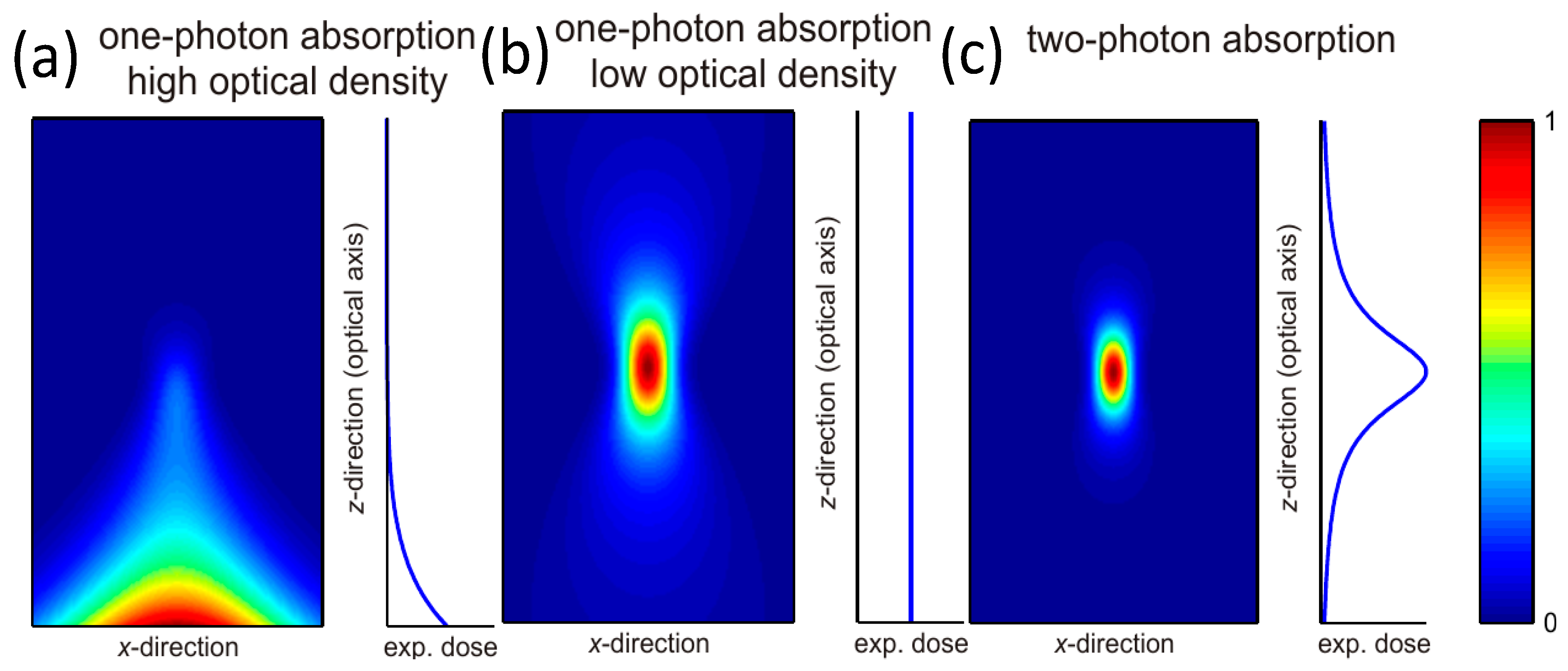
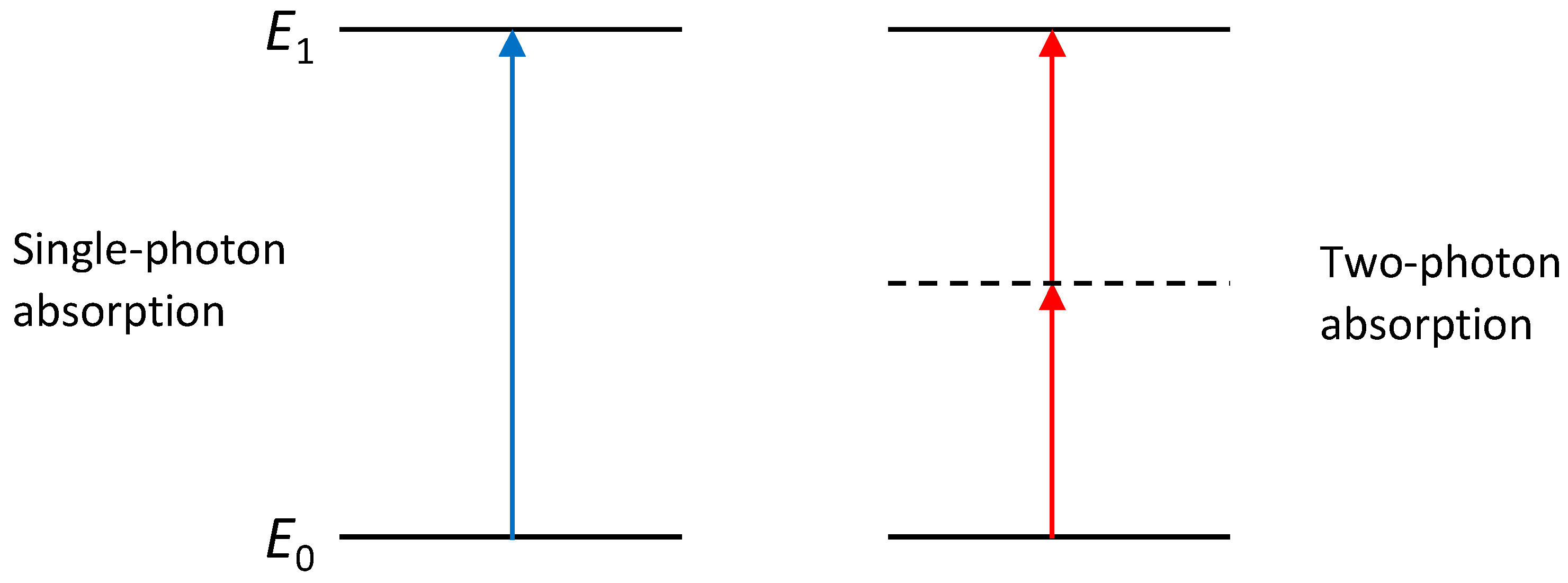
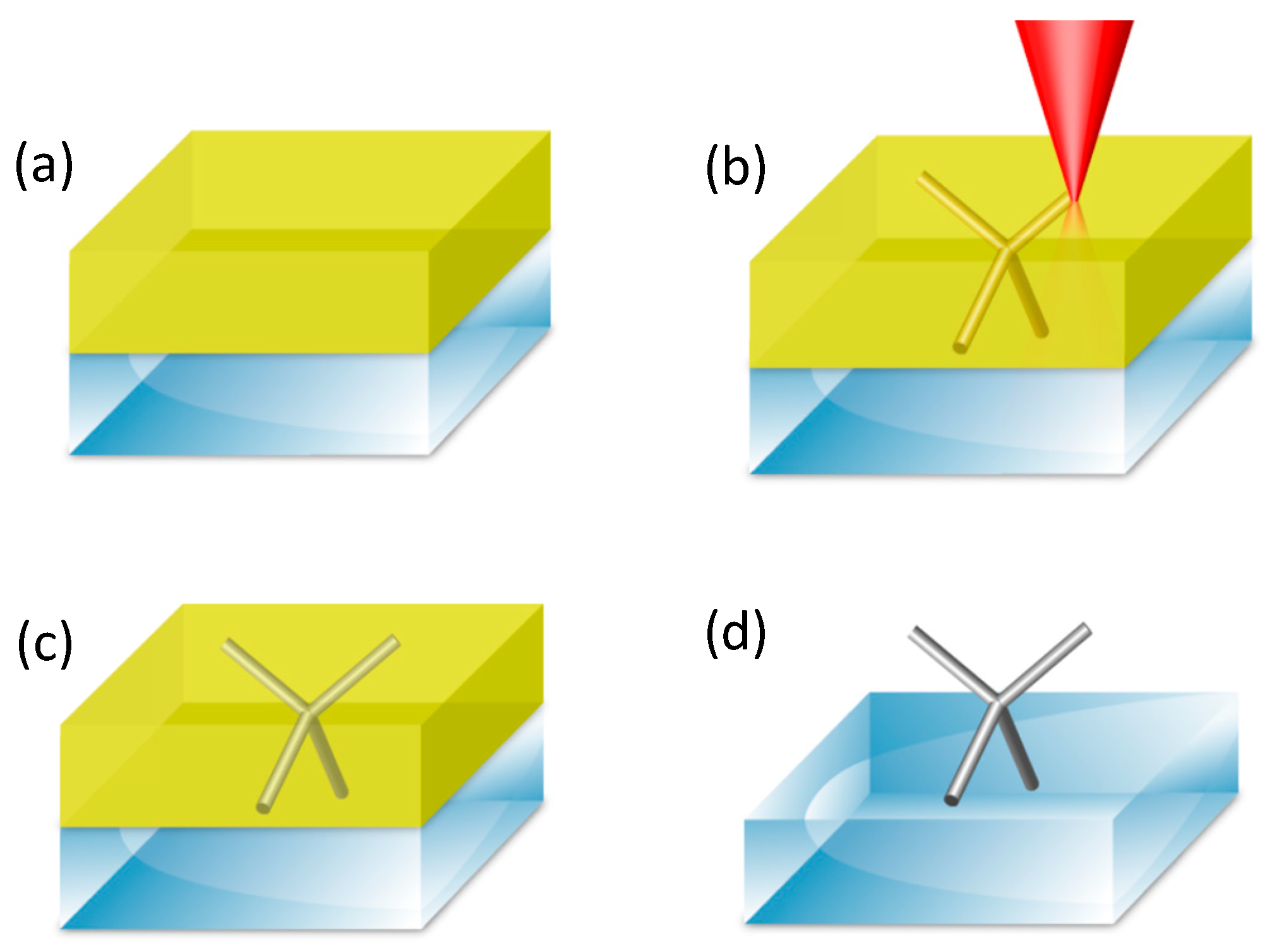
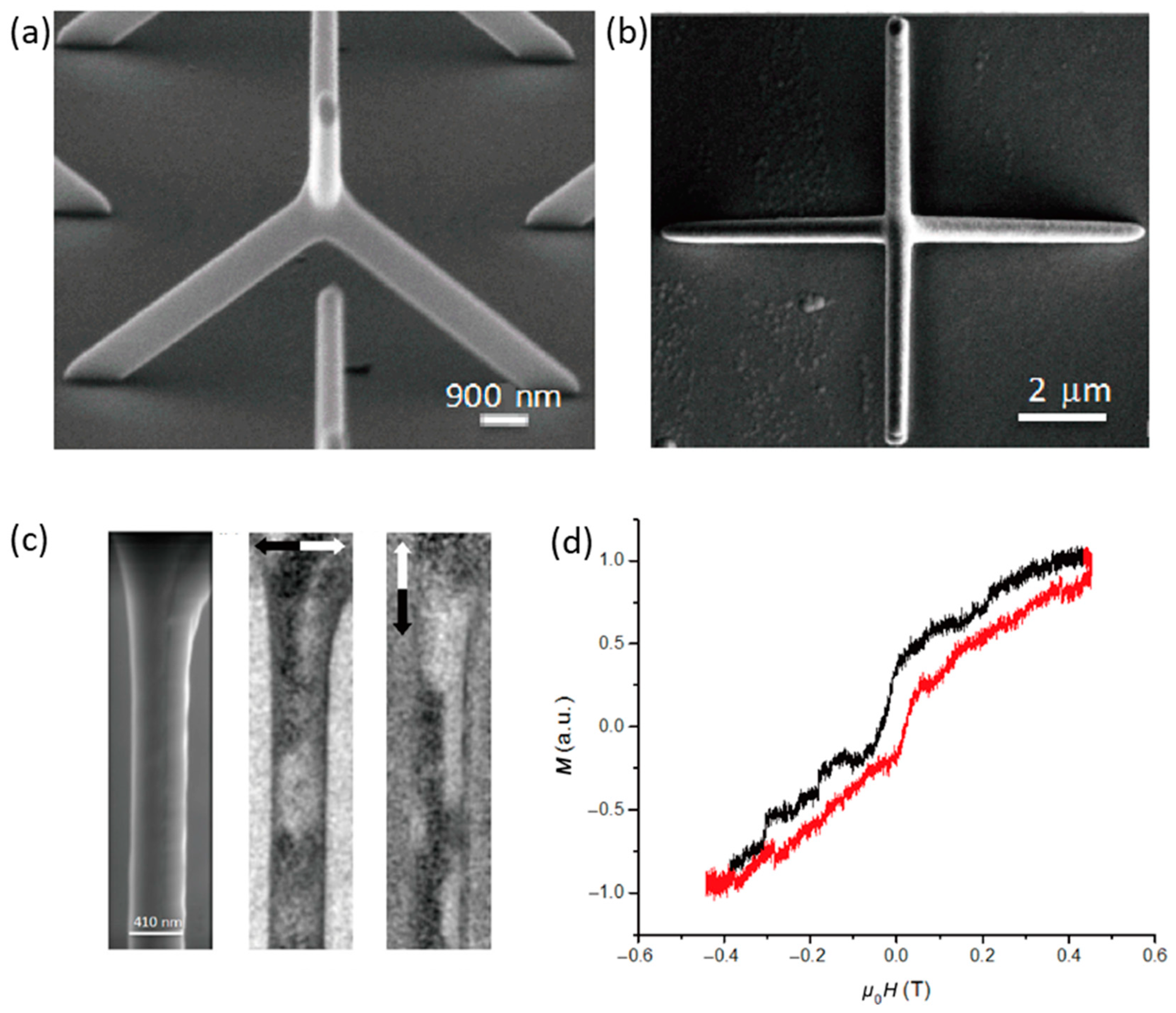

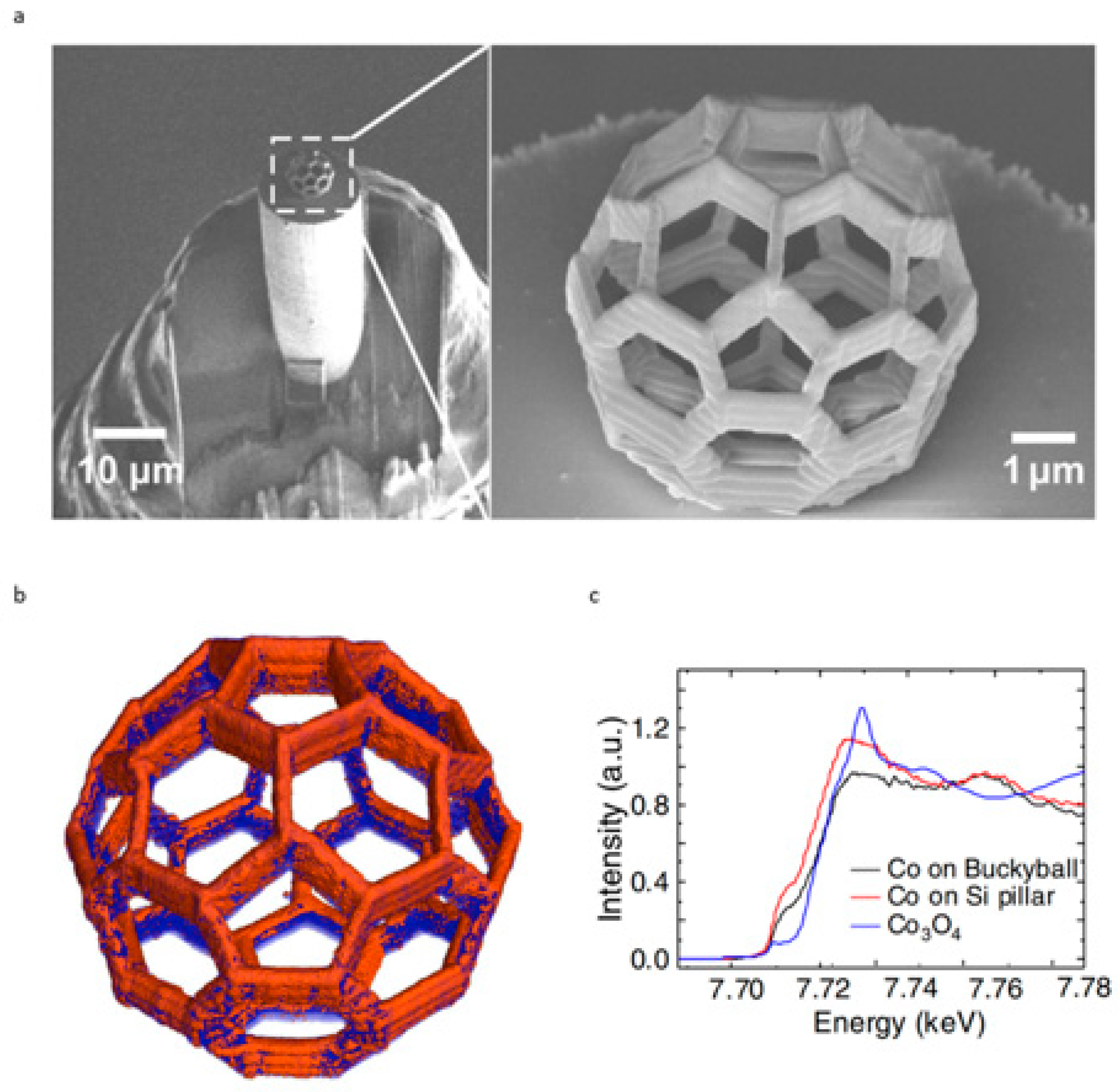
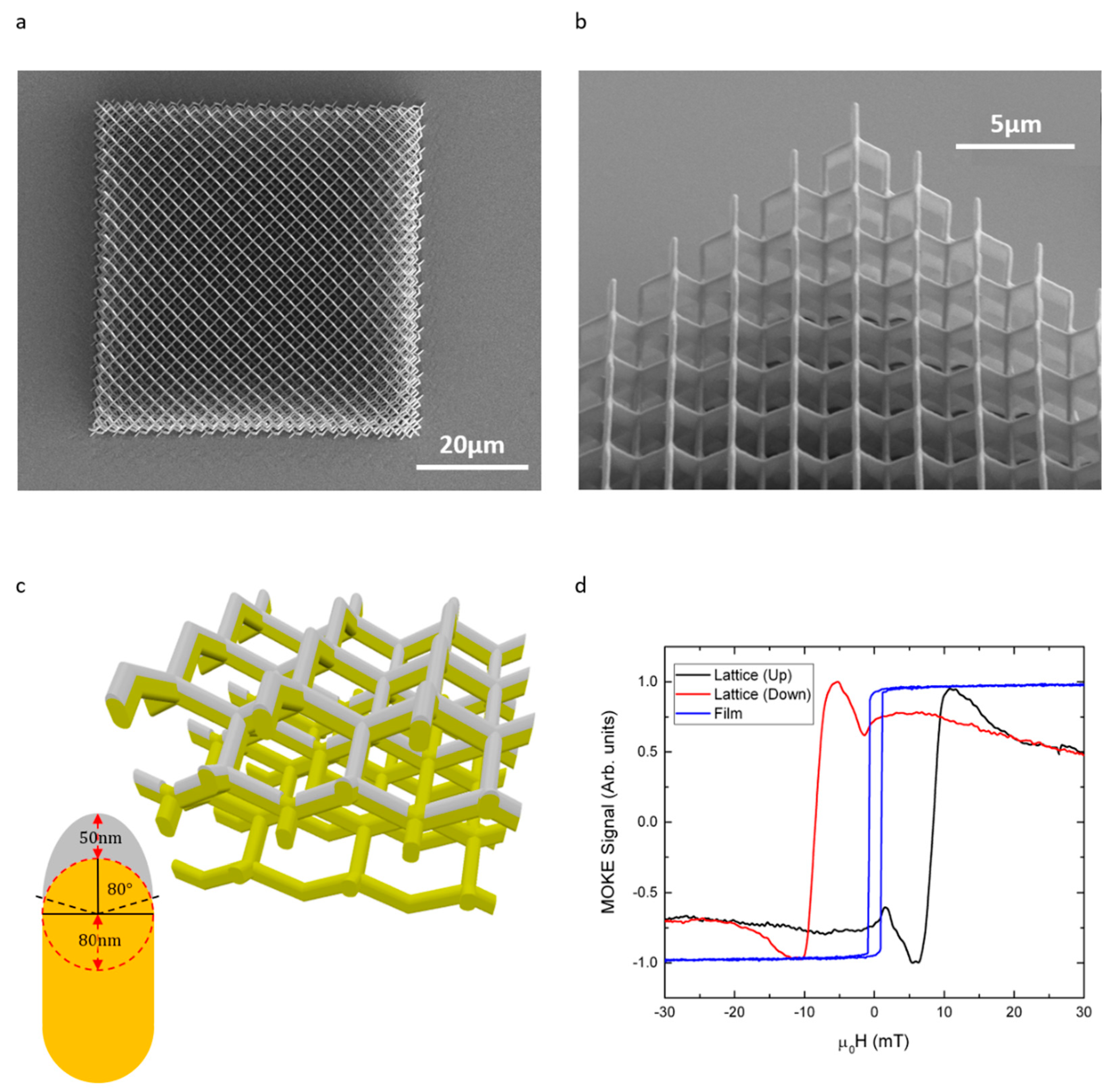
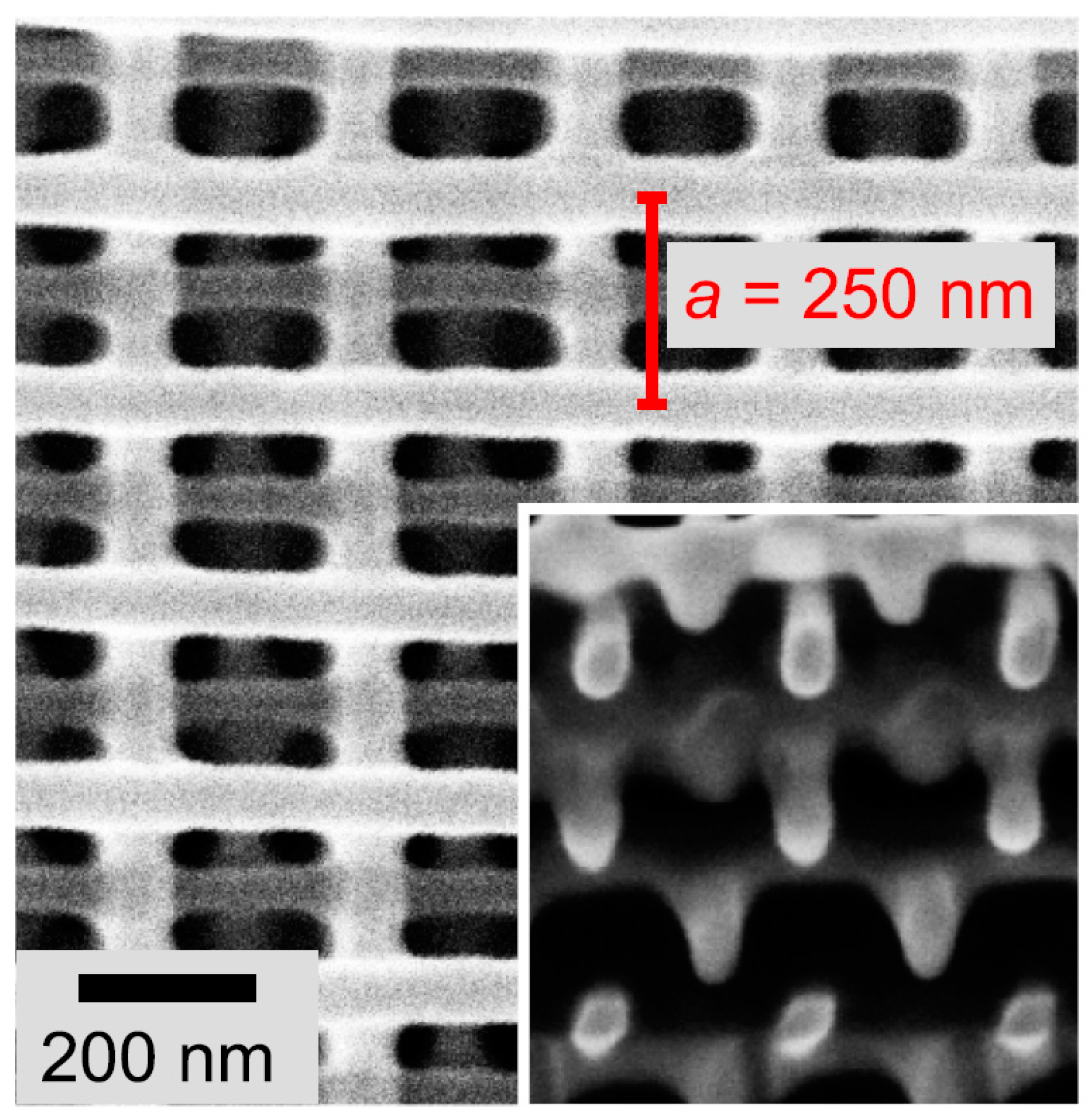
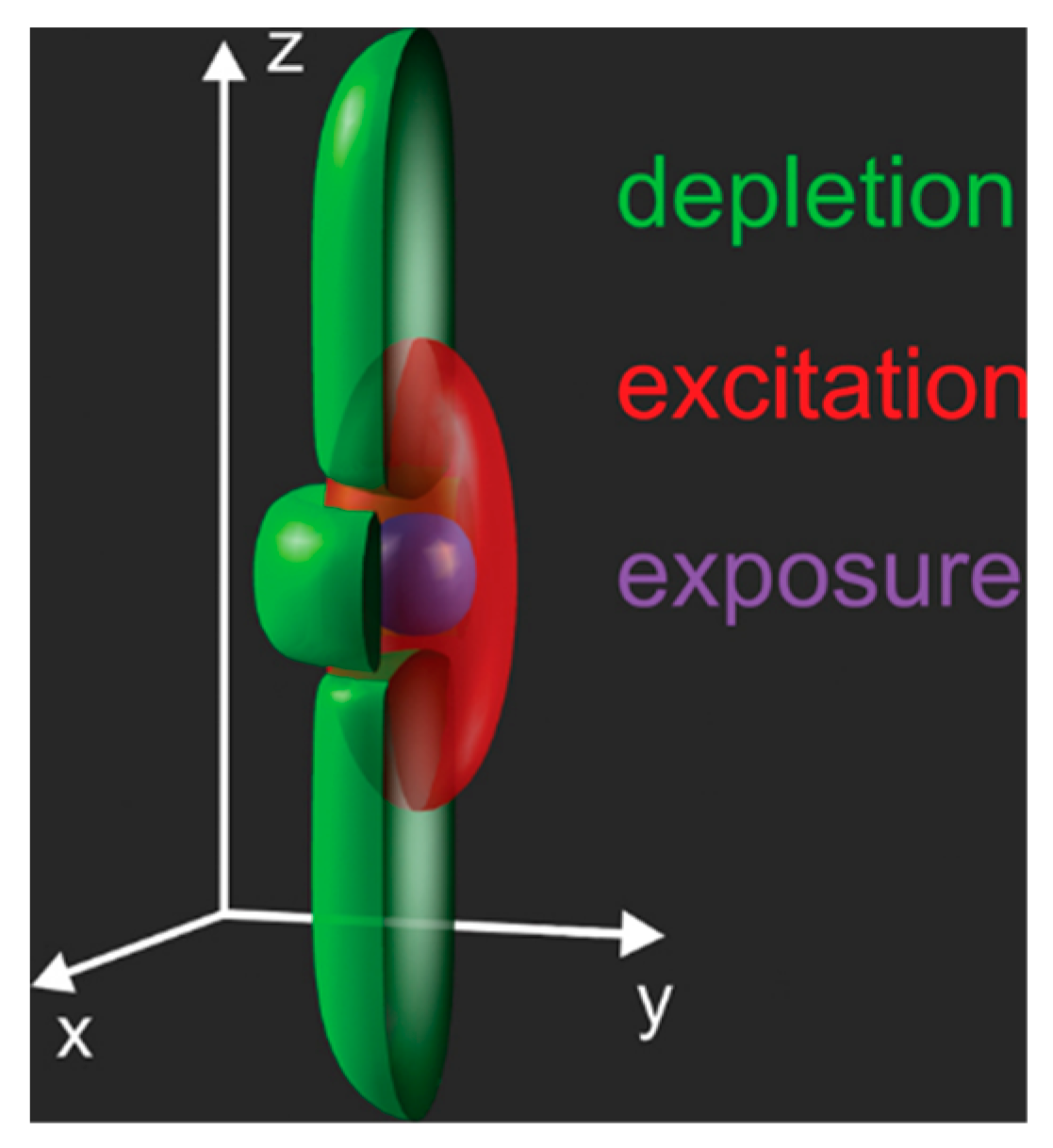
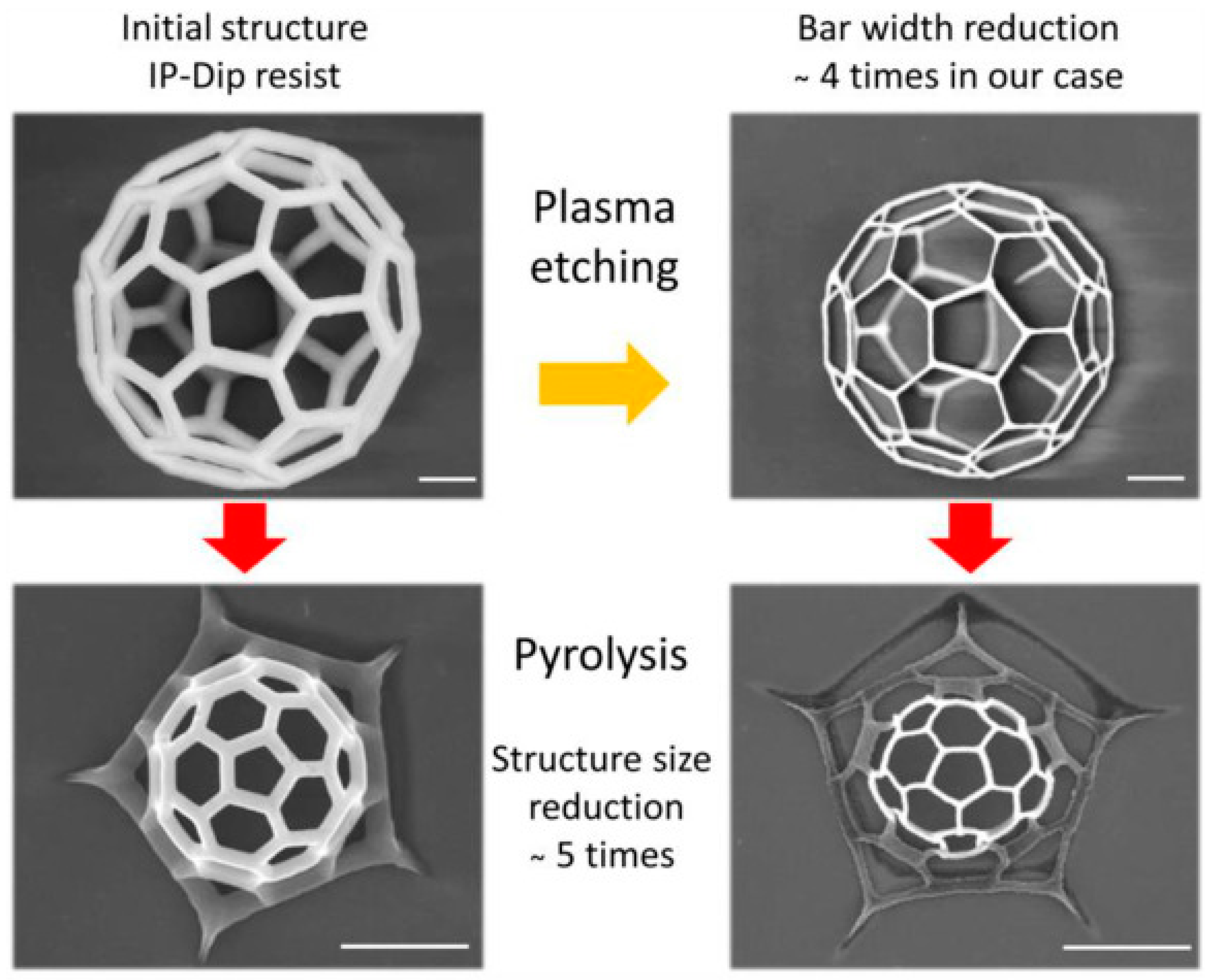
© 2020 by the authors. Licensee MDPI, Basel, Switzerland. This article is an open access article distributed under the terms and conditions of the Creative Commons Attribution (CC BY) license (http://creativecommons.org/licenses/by/4.0/).
Share and Cite
Hunt, M.; Taverne, M.; Askey, J.; May, A.; Van Den Berg, A.; Ho, Y.-L.D.; Rarity, J.; Ladak, S. Harnessing Multi-Photon Absorption to Produce Three-Dimensional Magnetic Structures at the Nanoscale. Materials 2020, 13, 761. https://doi.org/10.3390/ma13030761
Hunt M, Taverne M, Askey J, May A, Van Den Berg A, Ho Y-LD, Rarity J, Ladak S. Harnessing Multi-Photon Absorption to Produce Three-Dimensional Magnetic Structures at the Nanoscale. Materials. 2020; 13(3):761. https://doi.org/10.3390/ma13030761
Chicago/Turabian StyleHunt, Matthew, Mike Taverne, Joseph Askey, Andrew May, Arjen Van Den Berg, Ying-Lung Daniel Ho, John Rarity, and Sam Ladak. 2020. "Harnessing Multi-Photon Absorption to Produce Three-Dimensional Magnetic Structures at the Nanoscale" Materials 13, no. 3: 761. https://doi.org/10.3390/ma13030761
APA StyleHunt, M., Taverne, M., Askey, J., May, A., Van Den Berg, A., Ho, Y.-L. D., Rarity, J., & Ladak, S. (2020). Harnessing Multi-Photon Absorption to Produce Three-Dimensional Magnetic Structures at the Nanoscale. Materials, 13(3), 761. https://doi.org/10.3390/ma13030761








